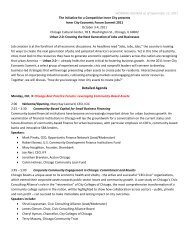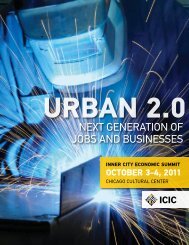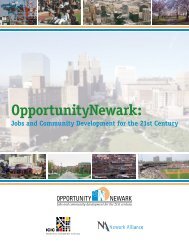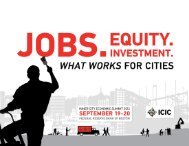An Analysis of Retail Markets in America's Inner Cities
An Analysis of Retail Markets in America's Inner Cities
An Analysis of Retail Markets in America's Inner Cities
You also want an ePaper? Increase the reach of your titles
YUMPU automatically turns print PDFs into web optimized ePapers that Google loves.
RETAIL<strong>in</strong>INNER CITIES<br />
(WAL-MART SUPERCENTER, HOWELLL MILL, ATLANTA)<br />
National retailers<br />
have been mov<strong>in</strong>g,<br />
albeit slowly, <strong>in</strong>to<br />
high-density urban<br />
areas for much<br />
<strong>of</strong> the past decade.<br />
Wal-Mart is the<br />
latest, and most<br />
visible, company<br />
to target this<br />
emerg<strong>in</strong>g market.<br />
(WAL-MART, CHICAGO)<br />
kets require retailers and developers not only<br />
to adapt their cookie-cutter suburban models<br />
to suit urban conditions, <strong>in</strong>clud<strong>in</strong>g vertical<br />
architecture, but also to gear the stores to<br />
the preferences <strong>of</strong> diverse, multiethnic, multil<strong>in</strong>gual<br />
customers. Several pioneer retailers<br />
already have blazed trails <strong>in</strong>to select cities,<br />
provid<strong>in</strong>g a model for others to follow. These<br />
companies have shown that penetrat<strong>in</strong>g the<br />
<strong>in</strong>ner-city market is not as prohibitively difficult<br />
as it once seemed, and that the reward<br />
can be worth the effort. With retail venues <strong>in</strong><br />
the suburbs already well covered, analysts<br />
suggest that <strong>in</strong>ner cities are virtually the only<br />
rema<strong>in</strong><strong>in</strong>g domestic market with significant<br />
growth opportunities.<br />
Moreover, unlike the Ch<strong>in</strong>ese, residents<br />
<strong>of</strong> U.S. <strong>in</strong>ner cities already have well-honed<br />
shopp<strong>in</strong>g <strong>in</strong>st<strong>in</strong>cts, arguably at least as well<br />
developed as those <strong>of</strong> their suburban counterparts.<br />
Clearly, Wal-Mart has recognized the<br />
similarities <strong>of</strong> the new foreign and domestic<br />
target markets and is adapt<strong>in</strong>g its rigid formats<br />
to meet local needs.<br />
Last fall, the Initiative for a Competitive<br />
<strong>Inner</strong> City (ICIC), a national, nonpr<strong>of</strong>it economic<br />
development organization that focuses<br />
on improv<strong>in</strong>g the economy <strong>in</strong> low-<strong>in</strong>come<br />
urban neighborhoods, published the f<strong>in</strong>d<strong>in</strong>gs<br />
<strong>of</strong> a comprehensive study <strong>of</strong> retail markets <strong>in</strong><br />
100 <strong>of</strong> the nation’s largest cities. The <strong>in</strong>ner<br />
city is def<strong>in</strong>ed by ICIC as core urban neighborhoods<br />
<strong>in</strong> which the poverty rate and unemployment<br />
rate <strong>of</strong> residents are 1.5 times or<br />
more than they are <strong>in</strong> their metropolitan statistical<br />
areas (MSAs). The study, conducted <strong>in</strong><br />
collaboration with the Boston Consult<strong>in</strong>g<br />
Group, found that <strong>in</strong> <strong>in</strong>ner cities with more<br />
than 10,000 households, the retail market is<br />
approximately $122 billion. It also found that<br />
approximately 35 percent <strong>of</strong> that total, or $42<br />
billion, currently is served by bus<strong>in</strong>esses<br />
located outside the <strong>in</strong>ner city. Unmet needs<br />
range across all retail categories. Restaurants,<br />
bars, and apparel shops are relatively well<br />
represented <strong>in</strong> <strong>in</strong>ner cities, but grocery stores,<br />
pharmacies, and build<strong>in</strong>g supply centers,<br />
among others, are still <strong>in</strong> short supply.<br />
“The <strong>in</strong>ner-city retail opportunity is<br />
immense,” says Michael Porter, a Harvard<br />
Bus<strong>in</strong>ess School pr<strong>of</strong>essor who founded ICIC<br />
<strong>in</strong> 1994. “<strong>Retail</strong> is one <strong>of</strong> the biggest economic<br />
development opportunities <strong>in</strong> the <strong>in</strong>ner<br />
city. It has tremendous w<strong>in</strong>/w<strong>in</strong> potential for<br />
both the community and retailers. But the<br />
potential rema<strong>in</strong>s unheeded,” he adds.<br />
The most recent study by ICIC follows up<br />
on <strong>in</strong>ner-city retail market research it had conducted<br />
<strong>in</strong> 1997. When the two studies are<br />
compared, aggregate totals suggest that little<br />
has changed <strong>in</strong> the <strong>in</strong>ner-city retail market<br />
dur<strong>in</strong>g the <strong>in</strong>terven<strong>in</strong>g years. Both the size<br />
<strong>of</strong> the market and the size <strong>of</strong> the unmet<br />
demand are relatively unchanged. But Porter<br />
contends that the aggregate figures mask the<br />
substantial growth <strong>of</strong> retail establishments <strong>in</strong><br />
<strong>in</strong>dividual cities that has occurred over the<br />
past decade. Accord<strong>in</strong>g to the study, <strong>in</strong>ner<br />
cities <strong>in</strong> Boston, San Diego, Denver, Oakland,<br />
Columbus, Ohio, and Harlem have significantly<br />
<strong>in</strong>creased both retail bus<strong>in</strong>esses and<br />
retail jobs. In cities at the other end <strong>of</strong> the<br />
spectrum—Buffalo, Louisville, Jacksonville,<br />
Detroit, Memphis, and St. Louis, among<br />
others—the retail supply gap has actually<br />
widened, the study found. [The complete<br />
study is available at www.icic.org.]<br />
Explanations vary as to why certa<strong>in</strong> cities<br />
are able to attract retail establishments while<br />
others are not. What is not <strong>in</strong> question, however,<br />
is the positive impact that new retail<br />
stores have on both <strong>in</strong>ner-city neighborhoods<br />
and residents. In <strong>in</strong>ner cities where retail has<br />
penetrated, improvements <strong>in</strong> both the local<br />
economy and the physical environment are<br />
easily detectable. The study found that <strong>in</strong><br />
the top 50 <strong>in</strong>ner cities—<strong>in</strong> terms <strong>of</strong> retail<br />
development—the size <strong>of</strong> the retail establishments<br />
has <strong>in</strong>creased by approximately 17 percent.<br />
Accord<strong>in</strong>g to Porter, <strong>in</strong>creased size is an<br />
<strong>in</strong>dication <strong>of</strong> both consolidation—fold<strong>in</strong>g<br />
many smaller stores <strong>in</strong>to a few larger ones—<br />
and greater efficiency. Both trends result <strong>in</strong><br />
better service and lower prices for consumers.<br />
Moreover, consolidation has produced more—<br />
not fewer—retail jobs.<br />
In most cases, retail development radically<br />
improves the appearance <strong>of</strong> long-neglected<br />
urban neighborhoods, replac<strong>in</strong>g vacant, sometimes<br />
contam<strong>in</strong>ated, lots with new build<strong>in</strong>gs<br />
and a flow <strong>of</strong> shoppers. Sister Virg<strong>in</strong>ia Morrison,<br />
executive director <strong>of</strong> the Grove Hall<br />
Neighborhood Development Association,<br />
located <strong>in</strong> Roxbury, Massachusetts, the heart<br />
<strong>of</strong> Boston’s <strong>in</strong>ner city, claims the five-acre<br />
JANUARY 2007 URBAN LAND 99








